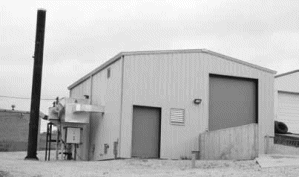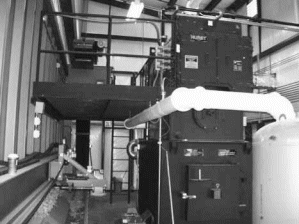Green Horizons
Volume 16, Number 1Winter 2012
Jason Jensen, Missouri Department of Conservation
 |
| Ellington Fuels for Schools project. All projects are equipped with electrostatic precipitators (unit between building and smoke stack) to reduce particulate matter |
As winter approaches and a new heating season begins, six Missouri schools will keep students warm using a non-traditional and renewable heating system. In 2009 the Missouri Department of Conservation was awarded a $6 million dollar grant through the American Recovery and Reinvestment Act (ARRA). This money was used to fund six new biomass thermal heating systems known as the Missouri Fuels for Schools projects.
"Missouri's schools, children, and forests will see lasting benefits from these Recovery Act projects," said U.S. Forest Service Chief Tom Tidwell. "Jobs, education, and healthy landscapes are what this work was all about."
 |
| Wood chips are augured from a storage bin onto a conveyor (lower left) to the combustor which sits beneath the boiler (right). |
Recipients of Fuels for Schools grants included Gainesville R-V School District, Mountain View- Birch Tree Liberty High School, Eminence R-I Elementary School, Southern Reynolds County R-II School District, Steelville R-III School District, and Perry County School District 32.
Ribbon cutting ceremonies were recently held to celebrate the completion of the six projects. Students were involved in many of the ceremonies, and Missouri's State Forester, Lisa Allen took advantage of the opportunity to explain the importance of forests to the state and how this new use of woody materials could enhance the benefits provided by forests such as clean air and water, wildlife habitat, scenic beauty and recreation.
"Healthy woods require care to maintain their growth and productivity. However, historically it has been difficult for Missouri's woodland owners to economically thin young trees because the trees being cut and removed had little commercial value," Allen said. "It is our hope that woody biomass burning boilers like the ones installed by the Fuels for Schools program will create a market that will entice landowners to improve their woodlands by thinning the trees. Such actions will also enhance wildlife habitat, potentially expand the forest products industry and support the local economy."
Five of the six projects will utilize wood chips as the primary feed stock. Wood chips are fed by auger and conveyor into a combustor. The combustor burns the chips which heat water in the boiler. The hot water is then piped throughout the school where heat is dispersed using heat exchangers. Eminence is the smallest of the systems and will utilize cordwood due to its smaller size.
The woody biomass boiler systems burn at over 80% efficiency, which helps to minimize emissions. To further reduce particulate matter emissions, electro-static precipitators (ESP's) were installed. The ESP's will essentially eliminate any particulate matter emissions.
In addition to utilizing a renewable fuel, the new heating systems are expected to save the schools money. On average the schools are expected to save 67% of their annual heating costs. According to Jason Jensen, the Forest Products Program Supervisor, wood chips are the cheapest fuel per Btu. Compared to other fuel sources on a per million Btu basis, wood chips cost only $5.00 compared to fuel oil at $22.64, propane at $25.44, and electric at $26.38. Wood chip markets have been much more stable over time when compared to other fuels such as propane. Schools are required to track and report heating costs so that more accurate cost estimates can be developed over time.
 |
| Heat exchangers like this one at Gainesville help to distribute heat evenly throughout the school. |
Another positive attribute is that wood is renewable and sourced locally. This provides jobs to local loggers and provides markets for sustainably harvested woody biomass. Markets for woody biomass can help ensure the health and productivity of our forests in Missouri.
A final benefit of the six projects is that they have set a precedent in Missouri. While other biomass projects exist in the state, none are as visible or accessible as the six school projects that were completed with this grant. Hopefully, other businesses and facilities will choose renewable energy to power and heat their facilities after they've seen the benefits to the schools. "The greatest accomplishment of this project is that schools are now using a local fuel source that is harvested in a local forest, by a local logger, transported and processed in a local mill then delivered to the school," Jensen said. "It's a success story in promoting the selfsustainability of the schools."
School administrators see the value and are proud of their completed projects. "We're proud to be piloting this program as an example to other schools across Missouri," said Charles James, Principal of Eminence Elementary School. "If other schools want to know where to go, well they can just follow us."
Photos courtesy of Peter Maki, Coordinator of Missouri Fuels for Schools